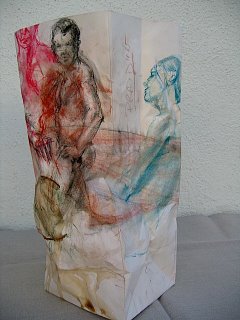
“I imagine my death -for me it’s a form of theology -as a gentle waning moonlight replacing the flicker of a scented candle.” He was drunk when he said this. In those early Paris years, Schoffman inclined toward the morbidly poetic when he had a few too many Pernods. It made a strong impression on me. Despite the sentimental stupidity of his mixed metaphors, I was impressed by David’s callow seriousness. He spoke of “the white milk moments” of his early affinities when he discovered Shostakovich’s quartets, Ribera, and the poetry of Fernando Pessoa. He was always a dreamer and I guess he still is, though now his dreams are shapeless and vague.
I wouldn’t say that success has tainted the integrity of David’s work, but woven through the threads of his renown are the echoes of melancholy. His new work is both beautiful and tragic, obsessive and restrained, thoroughly modern yet inexplicably obsolete.
“The Body Is His Book: One-Hundred Paintings” is a mercurial tour-de-force that ruminates on the dark potential of intelligent self-pity. It is a monument.






